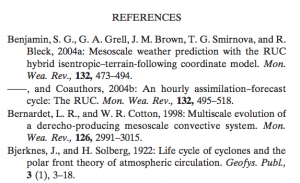Reference list style guides
 As an author, creating and double-checking reference lists in your manuscript are a hassle. Chances are if you make a mistake, a reader will go looking for that source and be stymied by a wrong year or incorrect page number. On top of the problems of accuracy, different journals require different formats for their reference lists. Few authors may know that many journals post their recommended formats online for authors considering submissions. Here are some of the more common formats I am aware of in atmospheric science.
As an author, creating and double-checking reference lists in your manuscript are a hassle. Chances are if you make a mistake, a reader will go looking for that source and be stymied by a wrong year or incorrect page number. On top of the problems of accuracy, different journals require different formats for their reference lists. Few authors may know that many journals post their recommended formats online for authors considering submissions. Here are some of the more common formats I am aware of in atmospheric science.
The American Meteorological Society has the Authors Resource Center as a clearinghouse for author information. One resource linked off this page (Journal Author Information) on this page is the Author Reference Guide.
This format is also adopted by the Electronic Journal of Severe Storms Meteorology.
The American Geophysical Union has an Authors Guide with reference formats inside. (Link at the bottom of this page.)
Wiley publishes the journals of the Royal Meteorological Society, such as the Quarterly Journal of the Royal Meteorological Society. Information for authors can be found here.
The journals of the European Geophysical Union are published by Copernicus. Their format of reference types can be found here.
The National Weather Association publishes several journals (including National Weather Digest and the Electronic Journal of Operational Meteorology). Their guide to authors for National Weather Digest, which includes referencing information applicable for all journals, can be found here.
Elsevier (publisher of Atmospheric Research, among others) has information for authors here.



I really like that the journals have adopted LaTeX which makes use of an automatic referencing system. The author can store relevant references in a file for use in their manuscripts. It really can take some of the hassle out of the writing process but it also introduces some as well, since you have to adapt a naming system to manuscripts for easy recall.